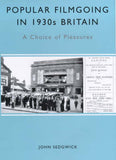University of Exeter Press
Popular Filmgoing in 1930s Britain
A Choice of Pleasures
- 328 Pages
In the 1930s there were close to a billion annual admissions to the cinema in Britain and it was by far the most popular paid-for leisure activity. This book is an exploration of that popularity. John Sedgwick has developed the POPSTAT index, a methodology based on exhibition records which allows identification of the most popular films and the leading stars of the period, and provides a series of tables which will serve as standard points of reference for all scholars and specialists working in the field of 1930s cinema. The book establishes similarities and differences between national and regional tastes through detailed case study analysis of cinemagoing in Bolton and Brighton, and offers an analysis of genre development. It also reveals that although Hollywood continued to dominate the British market, films emanating from British studios proved markedly popular with domestic audiences.
In the 1930s there were close to a billion annual admissions to the cinema in Britain and it was by far the most popular paid-for leisure activity. This book is an exploration of that popularity. The book establishes similarities and differences between national and regional tastes through case study analysis of cinemagoing in Bolton and Brighton.
"Sedgwick's attempt to bring about a new kind of synthesis of economic and cultural history, offering in the process a new way of assessing the relative popularity of the films that were available to the enormous cinema-going public in the Britain of the 1930s, is a resounding success. It should be essential reading for business historians, because it starts from the premise that the making and distribution of films is above all a business . . . A book which deserves to dominate its field for years to come, generating valuable follow-up research in the process." (Business History, 2002) "The book brings a valuable new economist's perspective to our understanding of cinema and a strong argument that British cinema enjoyed good health in the 1930s." (Contemporary British History, 2002) "Thorough and engaging . . . Fascinating to a wide range of scholars and students . . . A terrific bibliography that will allow any scholar or reader wishing to delve into the motion picture industry an easy leg up on the literature . . . While the rich data set that Sedgwick uses is from 1930s Britain, the points he highlights are general and should appeal to anyone with an interest in the economic or social history of the movies . . . The theories he proposes and the models he creates to test them are general in scope and leave lots of room for future scholars to follow his path and extend his research. In the end, he has produced a top-notch study of an industry that is under-explored in the economics literature. While focusing on a narrowly defined data set, he manages to produce a volume that cuts a wide swath through the history of the motion picture industry. It is a highly recommended read." (EH.NET, Aug 2001) "Sedgwick's work on popular film preferences constitutes probably the most thoroughgoing revisionist challenge to many of the accepted wisdoms of British cinema history at the present moment. His book will be eagerly awaited by historians." (James Chapman, Open University. Society for the Study of Popular British Cinema Newsletter, Autumn 1999) “Sedgwick’s study is extremely helpful for anyone interested in the actual leisure activities of the British public in the 1930s . . .The book addresses questions of local differences and provides a model for forward research in lucid prose which constantly returns the reader to the bigger questions under examination. It will be appreciated by both social and cultural as well as economic historians for the way it sets out its findings and suggests new pathways for understanding the development of cultural industries in the twentieth century.” (History, Vol. 87, No. 288, Oct 2002) “John Sedgwick’s Popular Filmgoing in 1930s Britain: A Choice of Pleasures is the most important and innovatory of the range of books under review here. Although it is a bracing (not to say challenging) read, it effectively redraws the map of British film scholarship… Overall, Sedgwick’s book is one of the most important to emerge in the field of British cinema in recent years, though no one would claim it was an easy read” (Journal of Contemporary History, Vol. 39, No. 3, 2004)
Contents: A simple theory of film choice; the context film in 1930s Britain; measuring popularity; shares in the British market; popular films and their stars in Bolton (worktown); comparative cinemagoing preferences, 1934-1935 - national, Bolton and Brighton audiences; profits, film budgets and popularity; genres, generic lineages and "hits"; stardom and "hits"; Michael Balcon's close encounter with the American market; difficulties facing the production sector of the British film industry during the late 1930s; conclusion. Appendices: the national sample cinema set; 126 London West End "hits" screened between 1 January 1932 and 31 March 1938; POPSTAT top 100 films in Britain, 1932-1937.
Couldn't load pickup availability















